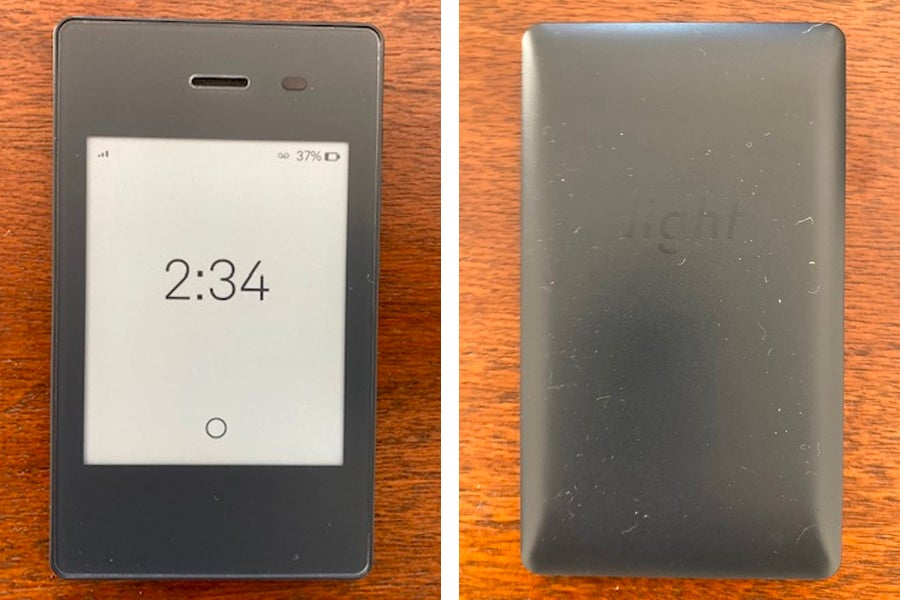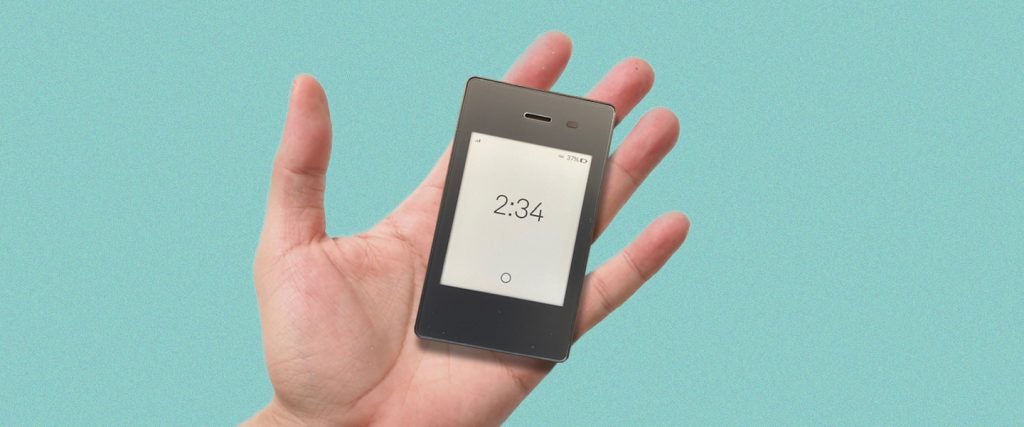I’m stuck in bumper-to-bumper traffic — red lights as far as I can see — and I’m late for a funeral. How long is the stoppage going to last? Is there a less crowded route? Should I get off the freeway and take surface streets instead?
I have no way of knowing: A few weeks earlier, I swapped my iPhone for a Light Phone II, a $350 mobile device that’s only capable of making calls and sending and receiving text messages. And so, as I’ve done many times since abandoning smartphone life, I call my girlfriend Sunny. “You sound like you’re underwater again,” she says. “I can barely hear you.”
“Hold on — let me take you off speaker,” I respond, though I’m fairly sure she can’t decipher this either.
Made from a block of matte plastic that’s slightly longer than a deck of cards and about as thin as an iPhone, the Light Phone II is the brainchild of Joe Hollier and Kaiwei Tang, an artist and product designer respectively who met in a Google experimental program in 2014. The first model was released in 2017. Business Insider declared that the “beautiful credit-card-sized phone just might cure your smartphone addiction,” and TechCrunch called it an “incredibly inspiring company.”
But the first Light Phone was so impractical — it only worked on 2G networks — that Hollier and Tang quickly went back to the drawing board. “The original Light Phone was only intended to be used as a casual ‘second phone,’” the creators wrote in a public manifesto a few months later. “The Light Phone II, however, is designed with the intention of being a fully functioning simple phone, whether it’s your ‘only’ phone or ‘second’ phone.”
Unlike the first model, which only made phone calls, the second was designed with the intention of completely replacing your smartphone. With the addition of a few more essentials like messaging and an alarm clock, Hollier and Tang created a custom “light” operating system using a black-and-white matte e-ink display — think of a cross between a Tamagotchi and an old Sony Ericsson. They’ve since added more “tools” — primarily, a calculator, a music player and a GPS. (I installed some of these features, but getting them to work turned out to be a real obstacle.)

As for how it came into my orbit, like most Americans, I spend way too much time on my phone, and I wanted to find a way to shake free of it. The Light Phone II seemed as good a place to start as any. But right off the bat, I learned that it’s not a great phone. The speakerphone is too easily activated by my ear, battering my eardrums when I least expect it, and if there’s a way to transfer my contacts over from my iPhone, I haven’t figured it out yet. So I’ve been having to respond to a not insignificant number of text messages with, “Sorry, new phone, who this?”
Worst of all, the touch screen is archaic. I don’t have particularly thick fingers, but I’ve stopped going back and trying to edit the mistakes I make when I’m typing short messages. I’ve also mostly just stopped texting people altogether, which hasn’t seemed to bother my family and friends, if only because they hate that my messages now show up as a green text message bubble.
Still, it isn’t all bad. When I go to bed at night, I no longer spend an extra hour trying to lull myself to sleep with headlines about how Will Smith slapped Chris Rock at the Oscars. And when I go to my grandma’s for dinner, while she spends most of the time on her iPad, I spend the night flipping through old photo albums and seeing pictures I’ve never seen before. Most memorably, on Persian New Year, when an older dude was choking on his food, I’m pretty sure that by not being on my phone, I saw him struggling to breathe long before anyone else and was able to give him the Heimlich before things got any worse. (True story.)
And yet, life-saving tool or not, everyone still mocks my Light Phone II. There are those who ask me what I’m doing on a kid’s phone. Others push one button before they get bored. But by far the most common response is what Wired dubbed the “this one thing” problem: “If only it just had email,” a family friend told me; another offered, “If only I could just listen to my Spotify playlists.”
My personal “this one thing” is the GPS. I downloaded it on my phone, but like so many others on the Light Phone subreddit, I quickly realized that it doesn’t work. Either the screen freezes, or it kicks into offline mode every time. “Offline mode works great,” writes one redditor. “But whenever I venture into the city, I really need GPS mode to recalculate when I hit construction. Instead, I get hopelessly lost.” Basically, you might have a sense of where you are, but figuring out exact directions to where you want to go becomes a major obstacle.
The strange thing is, the Light Phone’s inoperable GPS drove me nuts — until it didn’t. With little to no control over the length of my route, I now roll down all the windows, blast the radio and remember how much I used to like driving. There is no voice telling me to turn right or left. Or a red ticking clock constantly reminding me that I’m late. It’s just me and some streets I kinda, sorta know.
In nearly every review of the Light Phone II I’ve come across, the reviewer concludes that although the Light Phone II is an admirable attempt at curbing our addiction to technology, they simply cannot replace their smartphone with it. Instead, it’s often referred to as a great “digital detox.” To that end, CNET’s Jessica Fierro has written that while she loved using the Light Phone II because it allowed her to live in the moment, “it doesn’t really make sense for me to make the switch permanently because I work in social media and need some form of mobile access to apps like Instagram and TikTok to stay up on trends.”
For me, though, going “Light” has never actually equated to doing less. I’m still on my computer for eight hours a day, and if anything, the Light Phone II has only made that time more purposeful — I mean, I gotta get everything done, because I’m truly signing off at the end of the day. And again, more than a month since I first started using the Light Phone II, I’ve made peace with its limitations. I’ve most certainly been unsubscribed from some text message groups — people really hate the green bubble — but the trade-off is that I feel slightly more in control of how and when I’m online. If anything, I’ve grown to appreciate the moments when I’m genuinely bored.
Sure, without GPS, I’m more frequently getting lost in the world. But finding my own way — and forging my own path — hasn’t been such a bad way to reach my final destination either.

